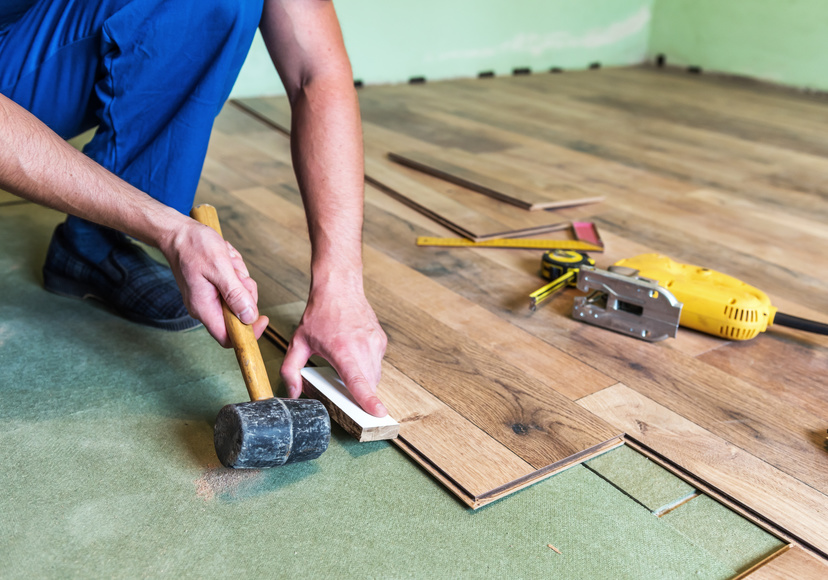Hardwood flooring is becoming the most popular floor option, eclipsing carpeting and laminate in the Bay Area, according to Bill Powell, of 123-Floor, a Marin flooring expert with more tha 20 years of experience.
Hardwood is popular for good reason.
“I look at hardwood as an asset in the house,” Powell says. It’s beautiful, durable, easy to clean, and a great alternative to carpet for people with allergy or asthma. With today’s products, he adds, there are lots of options to ensure you get the look you’re going for. “There are different patterns, different stains, different cuts.”
If you’re thinking about putting in new flooring, there are a few things to consider if you want to get the best performance out of your hardwood floor.
Concrete Slab or Wood Subfloor?
The first thing to know is what the new floor will sit atop, as there are different considerations for each type of underfloor.
Concrete Slab
Moisture is a top concern for all hardwood flooring, but it’s a particular challenge for homes that sit on a concrete slab, as do many mid-century moderns.
Changes in temperature and humidity make wood shrink and expand. The changes are small, but over a large area of floor, it can cause unsightly rippling or buckling.
Powell recommends engineered hardwood over solid hardwood flooring for these homes because it can be “floated” rather than nailed or glued to the surface.
Engineered hardwood uses a veneer of hardwood over plywood to create sections that snap or are glued together to create the flooring surface.
A floating floor allows for more movement without visible changes to the floor.
Wood Subfloor
Both engineered hardwood and solid hardwood flooring are suitable for laying over wood subfloors.
Because moisture can come up through the subfloor, many flooring professionals recommend adding a vapor barrier – a piece of plastic over the ground under the crawlspace – under the flooring.
Powell isn’t certain it’s necessary in Marin homes with well-ventilated crawlspaces.
“In our climate, if you have a properly ventilated crawlspace, you may be better off letting the vapor come up and get blown out to dissipate rather than trapping it on the ground,” he says.
The need for a vapor barrier is something to discuss with your contractor and architect as you’re planning for your new floor.
Radiant Heat and Your Hardwood Floor
Using hardwood flooring with radiant heat can be tricky. The heat from beneath the floor can exacerbate the wood’s shrinking and expanding. That’s why Powell will only lay a floating hardwood floor in a home with radiant heat.
The good news is that hardwood is becoming a better and better option for these homes.
“Ten years ago, hardly anyone would warrant a hardwood floor product for use over radiant heat. Fortunately, a lot of companies have come around since then, and there are a lot more choices,” Powell says.
In general, Powell recommends thinner products for use with radiant heat.
Durability of Hardwood Flooring
One advantage to solid hardwood over engineered hardwood is that it can be resanded and refinished numerous times, extending the floor’s useful life.
An engineered hardwood floor is more limited, but, contrary to what many believe, some products can be refinished.
“If you can spend an extra $2 per square foot [over typical big-box store products], you can get a product that can be resanded once or even twice,” says Powell. “That’s what I always recommend, unless you absolutely have to keep it as cheap as possible.”
Keep the Damp Out
As I noted above, moisture is the enemy of hardwood. In Marin, our climate can reach over 60 percent humidity during the winter rainy season; when coupled with a home’s heating, it can give hardwood flooring a beating.
Powell has two recommendations for combatting moisture:
- Choose a stable wood product – such as oak – for your flooring.
- Use a dehumidifier during the wet months.
Finding a Flooring Contractor
Because a floor is such an important part of your home, it’s essential to select a contractor with expertise in the type of floor you want. Your architect can connect you with flooring experts he or she trusts.
Powell suggests consumers do their due diligence when looking for a contractor.
“You’d be surprised how many people don’t even bother looking up the contractor’s license,” he says.
To do that, go to the California Contractors State License Board website and search for the contractor by name, business name or license number.
The results will tell you the contractor’s license status, classification, whether he or she carries worker’s compensation insurance (required if he or she has employees) and the required bond.
This post first ran in 2018.
Powell recommends asking whether a contractor also carries general liability insurance, which isn’t required by the licensing board, but can protect you if your contractor is unable to finish the job or makes a major error.


